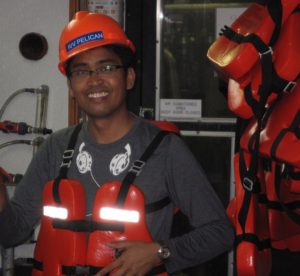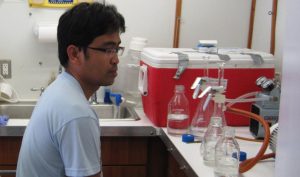Study Finds Environmental Factors Influence the Selection of Oil-Degrading Microbes
– JULY 24, 2018
Researchers conducted incubation experiments and examined the roles of temperature, nutrients, and initial bacterial community on oil biodegradation. Higher and lower temperatures yielded distinctly different bacterial community compositions, indicating that temperature is a key influencer of bacteria that respond when oil is present. Nutrients and the initial bacterial community may also influence how oil-degrading bacterial communities develop. Bacterial density correlated positively with alkane degradation but not with polycyclic aromatic hydrocarbon (PAH) degradation. Shifts in the bacterial community towards oil-degrading bacteria and genes may be a greater indicator of PAH degradation than bacterial density. The researchers published their findings in Frontiers in Microbiology: Potential environmental factors affecting oil-degrading bacterial populations in deep and surface waters of the northern Gulf of Mexico.
Microorganisms play a key role in oil weathering in marine environments. Hydrocarbon biodegradation rates and the development of oil-degrading bacterial communities likely depend on the oil’s composition and environmental conditions. However, previous studies investigating Deepwater Horizon oil biodegradation have not systematically examined the role of environmental factors on the development of bacterial communities when oil is present.
This study’s scientists collected surface (2 m depth) and bottom (1,537 m depth) water during a May 2013 research cruise on the R/V Pelican 1.4 km from the Deepwater Horizon site. The team analyzed contents of filtered and incubated water samples, some treated with oil and others left as controls, for nutrients, bacterial densities, community structures, and n-alkanes and PAHs – two major components of crude oil to represent biodegradation.
They chose 200 ppm for the experiment’s oil concentrations to be able to see enough of bacterial community change without being too dilute (not see community shift) or too high (lead to thick oil film formation). The team also chose that concentration so that they can compare results with previous studies that used 200 ppm. The experimental design is unique in that the researchers manipulated the incubations by switching surface and bottom waters in terms of water chemistry and initial bacterial communities.
“We set up incubations on the vessel’s deck to simulate in-situ environmental conditions at the oil spill site,” explained study author Zhanfei Liu. “As the first quantitative data, our results showed that temperature, initial community, oil, and water chemistry contributed to 57%, 19%, 14%, and 10% of the data variance of bacterial communities, respectively. We also revealed that a combination of environmental factors is often important in the development of certain bacterial degraders, such as 4°C and bottom bacterial community are key to the growth of Cycloclasticus and Pseudoalteromonas found in the subsurface oil plume.”
Dr. Liu explained why the experiments were incubated under surface pressure, “The goal of this study is to tease out the roles of environmental conditions in controlling the development of oil degraders, as opposed to simulating field conditions such as pressure. Also, the oil-degrading microbes that developed under surface pressure in our incubations are similar to those found in the subsurface oil plume, suggesting that pressure did not significantly affect our results. With this said though, the role of pressure needs to be further studied. Regardless, our conclusions about the key roles of temperature and initial community in controlling the development of oil degraders are robust and valuable for response and bioremediation of oil spills.”
Total n-alkanes generally degraded faster at 24°C than 4°C and faster in treatments using bottom water than treatments using surface water. Treatments using bottom water inoculated with unfiltered surface water incubated at 24°C consistently showed the highest alkane degradation rate, though no general pattern emerged for which inoculant yielded higher alkane degradation in alkane. Inversely, PAH degradation rates were faster at 4°C in treatments using filtered and unfiltered surface water.
Bacterial densities were 10-times higher in surface water than bottom water and increased in both oil and non-oil treatments; however, the increase was higher in oil-amended treatments. Surface and bottom water inoculum yielded the highest bacterial density growth in filtered bottom water incubated at 24°C.
The initial bottom water microbial community was primarily composed of α– and γ-Proteobacteria, Flavobacteria, Sphingobacteriia, Clostridia, and Opitutae with relative abundances of 46, 20, 8, 5, 4, and 3%, respectively. The community shifted to mainly α– and γ-Proteobacteria at 4°C and higher percentages of α-Proteobacteria and lower percentages of γ-Proteobacteria at 24°C. Flavobacteria, Deltaproteobacteria, Cytophagia, and Sphingobacteria also exhibited higher abundances at 24°C.
“This study offers key information regarding what types of oil degraders would develop for given environmental conditions and is important for predicting the natural response of marine ecosystems should there be another spill in the Gulf of Mexico,” Liu said. “It also offers support for the appropriate bioremediation strategies, i.e., applying the right oil degraders depending on specific environmental conditions.”
Data are publicly available through the Gulf of Mexico Research Initiative Information & Data Cooperative (GRIIDC) at doi:10.7266/N70K26K4 and doi:10.7266/N7VT1Q3V.
The study’s authors are Jiqing Liu, Hernando P. Bacosa, and Zhanfei Liu.
************
This research was made possible in part by a grant from the Gulf of Mexico Research Initiative (GoMRI) to the Dispersion Research on Oil: Physics and Plankton Studies II (DROPPS II) consortium. Other funding sources include the NSF Chemical Oceanography Program (OCE-1129659).
The Gulf of Mexico Research Initiative (GoMRI) is a 10-year independent research program established to study the effect, and the potential associated impact, of hydrocarbon releases on the environment and public health, as well as to develop improved spill mitigation, oil detection, characterization and remediation technologies. An independent and academic 20-member Research Board makes the funding and research direction decisions to ensure the intellectual quality, effectiveness and academic independence of the GoMRI research. All research data, findings and publications will be made publicly available. The program was established through a $500 million financial commitment from BP. For more information, visit https://gulfresearchinitiative.org/.
© Copyright 2010-2018 Gulf of Mexico Research Initiative (GoMRI) – All Rights Reserved. Redistribution is encouraged with acknowledgement to the Gulf of Mexico Research Initiative (GoMRI). Please credit images and/or videos as done in each article. Questions? Contact web-content editor Nilde “Maggie” Dannreuther, Northern Gulf Institute, Mississippi State University (maggied@ngi.msstate.edu).







